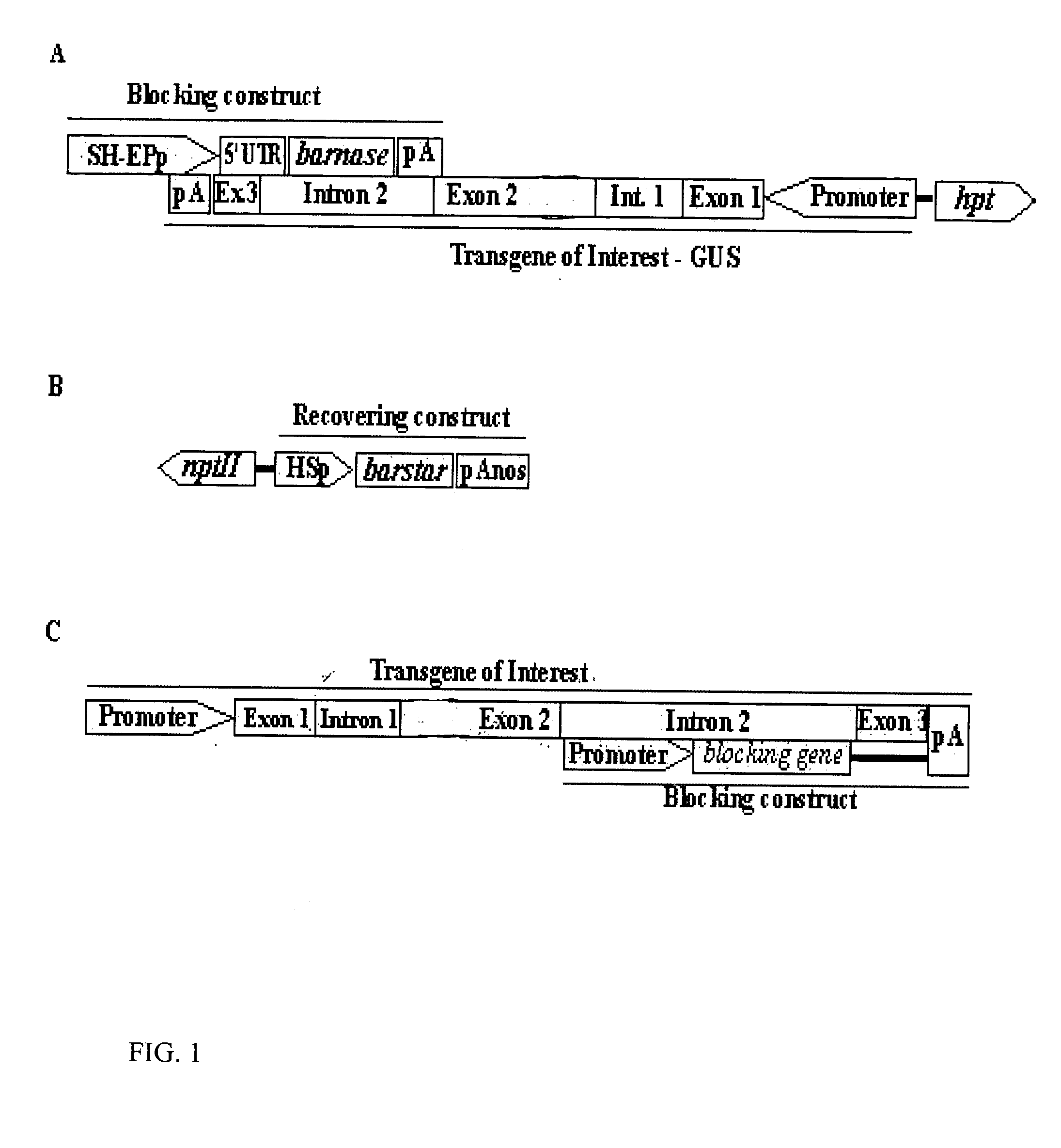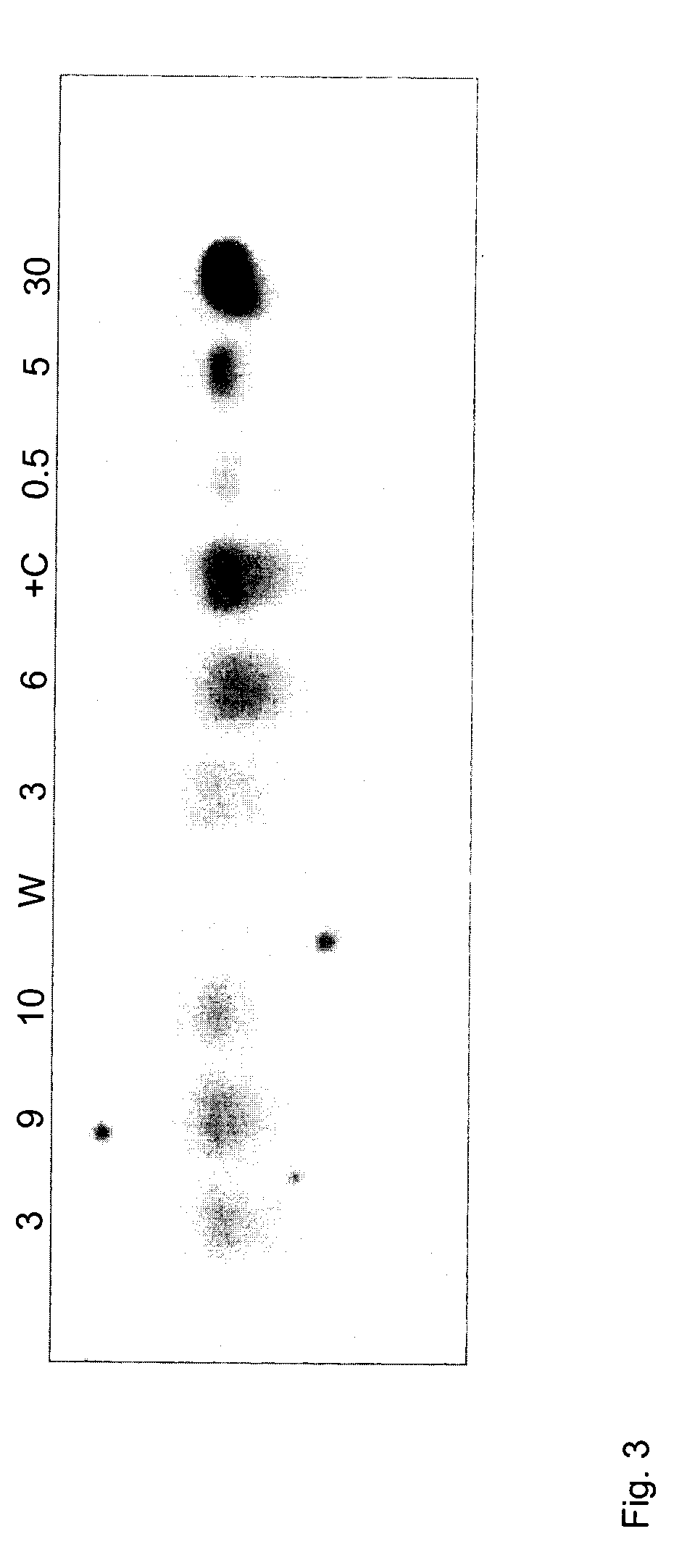Molecular mechanisms for gene containment in plants
a gene containment and molecular mechanism technology, applied in biochemistry, organic chemistry, biochemical apparatus and processes, etc., can solve the problems of bc expression leading to death or incapacity of sexual reproduction of plants
- Summary
- Abstract
- Description
- Claims
- Application Information
AI Technical Summary
Problems solved by technology
Method used
Image
Examples
example 1
DNA Synthesis and Cloning
[0072]The Barstar gene originating from Bacillus amyloliquefaciens was synthesized according to plant codon preference with low AT content (SEQ ID NO: 2). We used the GUS (uidA) gene containing an intron at the start of coding sequence for designing the intron cassette. The intron cassette containing the second intron sequence of GUS (SEQ ID NO:3) (between SpeI and PstI sites) harboring the barnase gene (SEQ ID NO: 1) and the third exon of the GUS (SEQ ID NO: 4) was split into two segments. Each segment was synthesized from 55-59-base long oligonucleotides in high fidelity PCR. The two segments were then ligated in EcoRI restriction site (FIG. 2).
[0073]Heat shock promoter of Glycine max and cysteine endopeptidase (SH-EP) promoter of Vigna mungo were also cloned using a high fidelity PCR.
[0074]The tetracycline repressor sequence (tetR) was also cloned in high fidelity PCR from E. coli strain XL1 and placed under the control of the 35S promoter. The RBF constr...
example 2
Design of the Intron Cassette
[0076]In this specific example we designed the Intron cassette so that barnase (BC) and GUS (TGI) genes are transcribed in opposite directions with respect to each other (FIG. 1A). Barnase coding sequence (SEQ ID NO: 1) was placed in the intron of GUS gene (FIG. 2). GUS gene was split in position 49 nucleotides upstream the stop codon. CGC codon of arginine has been changed to AGG to form splicing site between the two guanidines. Six nucleotides before the splicing site, a glutamine codon was changed from CAA to CAG to form a PstI restriction site. The sequence CGCTTTTCTG (SEQ ID NO: 8) upstream the PstI site was changed to TGCCTTCCTG (SEQ ID NO: 9) to introduce an additional alternative cleavage site for polyadenylation and to increase the GC content in the close vicinity of the intron. Restriction site PstI and the minor changes upstream of it were introduced by PCR amplification of GUS gene sequence using long 5′ primer containing the modifications de...
example 3
A Segregating Type of RBF having an Intron Cassette with Organ Specific Expression of BC and Inducible Expression of TGI
[0078]In order to achieve a segregating type of RBF we developed a DNA construct, where BC is situated in the intron of TGI and the RC is inserted in a different chromosome (FIG. 1a and b). The segregating RBF provides control for TGI containment after the RC segregates apart the construct carrying the TGI and the BC. After RC segregates apart, expression of the BC prevents the reproduction of plants carrying the TGI linked with BC. BC was placed under an organ-specific promoter, which in this example was cysteine endopeptidase (SH-EP) from Vinga mungo. Other organ-specific promoters could be used as well. A functional example of other promoters is Crusiferine promoter from Brassica napus.
[0079]In this example the RC was regulated by heat shock promoter of Glycine max, and thereby the RBF was heat shock inducible. Other heat shock promoters or could be used as wel...
PUM
| Property | Measurement | Unit |
|---|---|---|
| frequency | aaaaa | aaaaa |
| size | aaaaa | aaaaa |
| color | aaaaa | aaaaa |
Abstract
Description
Claims
Application Information
 Login to View More
Login to View More - R&D
- Intellectual Property
- Life Sciences
- Materials
- Tech Scout
- Unparalleled Data Quality
- Higher Quality Content
- 60% Fewer Hallucinations
Browse by: Latest US Patents, China's latest patents, Technical Efficacy Thesaurus, Application Domain, Technology Topic, Popular Technical Reports.
© 2025 PatSnap. All rights reserved.Legal|Privacy policy|Modern Slavery Act Transparency Statement|Sitemap|About US| Contact US: help@patsnap.com



